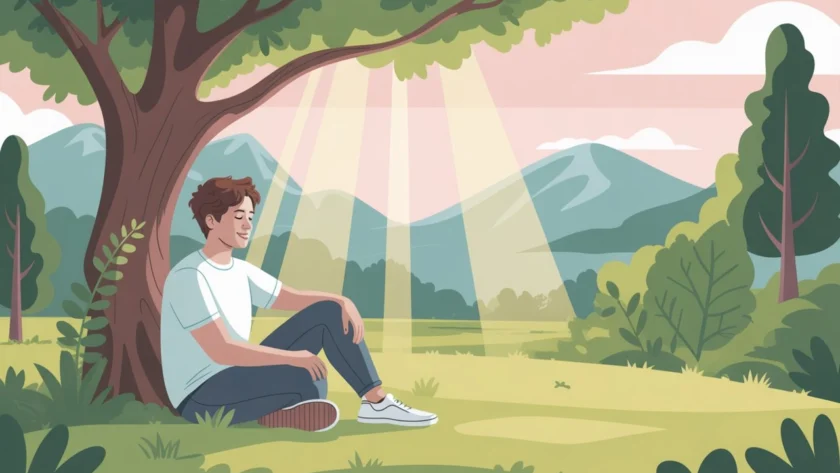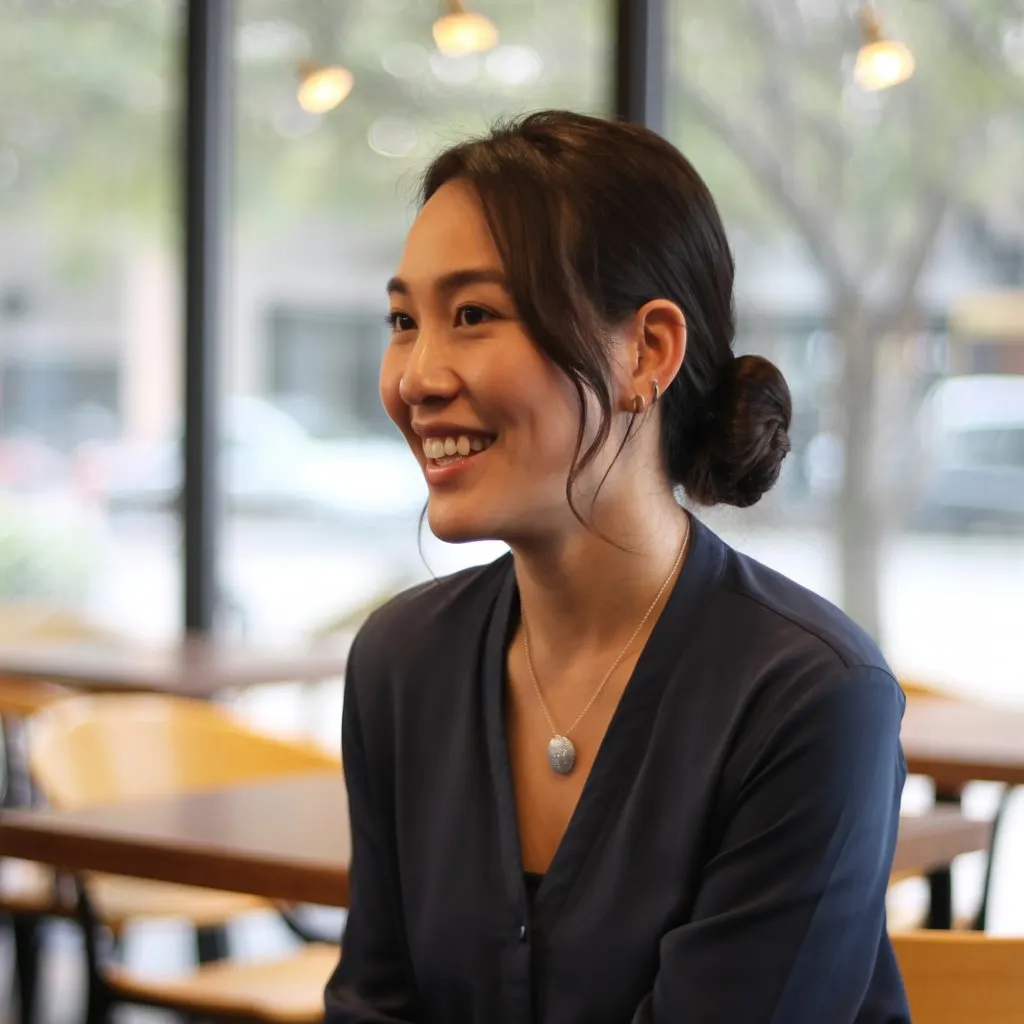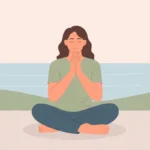I’ll never forget the morning I sat on my back porch, coffee in hand, watching Bailey (my rescue dog) chase butterflies through the garden. My chest was tight with that familiar anxiety that had been my unwelcome companion for weeks. But as I watched the sunlight filter through the oak leaves and felt the morning breeze on my face, something shifted. Not dramatically—more like a gentle exhale I didn’t know I’d been holding.
That moment started my journey into understanding something I’d known instinctively but hadn’t fully embraced: nature has a unique power to quiet our anxious minds in ways that four walls simply can’t. And here’s what really struck me—this isn’t just feel-good advice. There’s something deeply spiritual and profoundly practical about how spending time outdoors can provide anxiety relief.
If you’ve been struggling with anxiety and feel like you’ve tried everything, let me share what I’ve discovered about the healing power of simply stepping outside.
Why Nature Works When Anxiety Won’t Let Go
You know that feeling when your mind is spinning with worry and your body feels like it’s vibrating with nervous energy? I’ve been there more times than I can count. What I’ve learned is that anxiety often traps us in our heads—in cycles of what-if thinking that feel impossible to escape.
Nature interrupts those cycles in the most gentle way possible.
When I’m outdoors, my senses get engaged in something beyond my anxious thoughts. The rustling leaves, the bird songs, the way sunlight dapples through branches—these things pull me into the present moment. And anxiety? Anxiety lives in the future or rehashes the past. It can’t survive very long when we’re truly present.
There’s actually a biblical foundation for this that I find beautiful. Genesis tells us that God placed the first humans in a garden—not a building, not a city, but surrounded by creation. Throughout scripture, significant encounters with God often happen outdoors. Moses and the burning bush. Elijah in the wilderness. Jesus praying in Gethsemane’s garden. Maybe there’s something about being in creation that helps us connect with our Creator and find the peace He offers.
I’ve come to believe that when we step outside, we’re stepping into a sanctuary God designed specifically for our healing.
The Science Behind Nature’s Calming Effect

Now, I’m not someone who thinks we have to choose between faith and science—I believe God often works through the natural systems He created. And what researchers have discovered about nature and anxiety relief is fascinating.
When we spend time outdoors, our bodies respond in measurable ways. Cortisol—that stress hormone that anxiety loves to flood our systems with—actually decreases. I’ve felt this myself. After twenty minutes of walking through my neighborhood park, that tight, jittery feeling in my chest starts to ease. My breathing naturally deepens. The constant mental chatter quiets down.
There’s also something called “soft fascination” that happens in nature. Unlike the demanding attention that screens and urban environments require, natural settings gently capture our focus. A flowing stream, swaying trees, clouds drifting by—these things engage our attention without exhausting us. For those of us prone to mental fatigue from constant worry, this is incredibly restorative.
What really got my attention is research on what happens to our nervous systems outdoors. That fight-or-flight response that anxiety keeps triggering? Nature helps shift us into rest-and-digest mode. It’s like creation itself is whispering, “You’re safe. You can rest now.”
Forest Bathing: More Than Just a Walk in the Woods
The first time I heard about “forest bathing,” I thought it sounded a bit out there. But then I learned it’s an actual practice called shinrin-yoku in Japan, where it’s been used for decades as preventive medicine. And honestly? It’s changed how I approach my own anxiety management.
Forest bathing isn’t about hiking or exercising—it’s about immersing yourself in the forest atmosphere. It’s intentional, slow, and mindful. When I practice it, I’m not trying to get anywhere or accomplish anything. I’m simply being present with the trees, the earth under my feet, the quality of light filtering through leaves.
Here’s what a typical forest bathing experience looks like for me:
I find a wooded area—doesn’t have to be wilderness, even a tree-lined park works. I leave my phone in the car (this is crucial). Then I walk slowly, pausing often. I might spend five minutes just watching how light moves through branches. I’ll touch tree bark, noticing its texture. I breathe deeply, taking in that earthy scent that only forests have.
The key is engaging all your senses, not just your eyes. What do you hear? Not just birds, but the quality of silence between sounds. What do you smell? Pine, earth, that green scent of growing things. What do you feel? Air temperature, humidity, the give of soil under your feet.
I often pray during these times, but not in a structured way. It’s more like an ongoing conversation with God, thanking Him for the beauty around me, asking Him to help me notice His presence, inviting His peace into my anxious heart.
Studies have shown that forest bathing can lower blood pressure, reduce stress hormones, improve mood, and boost immune function. But what I’ve experienced goes deeper than statistics—it’s a sense of being held by something larger than my worries.
Ecotherapy: Healing Through Connection with Creation
While forest bathing is one approach, ecotherapy encompasses a broader range of nature-based healing practices. I’ve incorporated several of these into my anxiety management routine, and they’ve become as important as any other tool in my wellness toolkit.
Gardening has been particularly transformative for me. There’s something about putting my hands in soil, planting seeds, and watching things grow that speaks to my soul. When anxiety makes me feel out of control, gardening reminds me that growth happens in its own time. You can’t rush a tomato plant, no matter how much you worry about it.
I see spiritual parallels everywhere in my garden. Jesus talked about seeds and soil for a reason—these are profound metaphors for faith and growth. When I’m pulling weeds, I’m reminded to pull anxious thoughts before they take root. When I’m watering plants, I think about how God’s presence nourishes my spirit even when I can’t see immediate results.
Some people find ecotherapy through conservation work—joining cleanups or restoration projects. Others discover it through nature photography, birdwatching, or simply sitting by water. The specific activity matters less than the consistent connection with the natural world.
What I’ve learned is that ecotherapy works partly because it gets us out of our isolated, internal worlds. Anxiety is incredibly self-focused—not because we’re selfish, but because it demands our attention. Nature gently redirects that focus outward, reminding us we’re part of something much bigger.
Practical Ways to Use Nature for Anxiety Relief
Let me share some specific practices that have made a real difference in my anxiety levels. These aren’t complicated or time-consuming, which is important because when anxiety is high, we need simple, accessible tools.
Morning Nature Moments: Even if it’s just ten minutes on your porch or balcony with your coffee, start your day outside. I do this almost daily now. I notice the weather, listen to birds, feel the air. It sets a calmer tone for the entire day. I’ll often pray a simple prayer: “God, help me notice Your presence today. Calm my anxious heart.”
Walking Meditation Outdoors: Instead of walking for exercise, try walking as a form of moving meditation. Walk slowly. Notice each footstep. Breathe in rhythm with your steps. When anxious thoughts come (and they will), acknowledge them gently and return your focus to the sensation of walking, the sights around you, the feeling of being held by God’s creation.
Nature Sit Spots: Find one special place outdoors where you can sit regularly—a park bench, a spot under a tree, a quiet corner of your yard. Visit it often, at different times of day and in different weather. Getting to know one place intimately creates a sense of sanctuary. This becomes your outdoor prayer closet.
Barefoot Grounding: When weather permits, take off your shoes and stand on grass or earth. There’s emerging research about the benefits of direct contact with the ground, but even without the science, it just feels good. It’s grounding in every sense. I like to pray Psalm 46:10 while doing this: “Be still, and know that I am God.”
Nature Gratitude Practice: When you’re outside, actively look for things to be grateful for. Not in a forced way, but genuinely noticing. The color of a flower. The way clouds move. A bird’s song. Gratitude and anxiety can’t occupy the same space in our hearts at the same time.
When Getting Outside Feels Impossible
Here’s something I need to acknowledge because it’s real: sometimes anxiety makes it hard to even leave the house. I remember months where going to my mailbox felt like climbing Everest.
If you’re in that place right now, please hear me—start smaller than small. Open a window and let fresh air in. Sit by a window where you can see trees or sky. Bring nature inside with houseplants. Listen to nature sounds—there are apps with forest sounds, ocean waves, rain.
I’m not minimizing your struggle. I’m saying there’s no right way to do this. Any connection with nature counts.
When I was at my most anxious, I couldn’t handle full forest bathing experiences. But I could sit on my back step. I could water my potted plants. I could look at pictures of nature and remember that the world is bigger than my anxiety.
Be patient with yourself. God meets us exactly where we are, even if where we are is struggling to walk to the end of the driveway.
Combining Nature Time with Prayer and Scripture
One of the most powerful things I’ve discovered is deliberately combining time in nature with spiritual practices. This isn’t about multitasking—it’s about recognizing that being in creation can deepen our connection with our Creator.
I’ll often take a scripture with me on walks. Not to study intensively, but to let it sink deeper as I’m surrounded by the world God made. Psalm 23 hits differently when you’re actually sitting beside still waters. Matthew 6:26—”Look at the birds of the air”—becomes experiential rather than theoretical when you’re literally watching birds.
Sometimes I practice lectio divina outdoors—a contemplative way of reading scripture slowly, letting words and phrases settle into your heart. The pace of this ancient practice matches beautifully with the slower rhythm of being in nature.
Other times, I don’t use words at all. I just sit in God’s presence, letting the beauty around me be a form of prayer. Brother Lawrence talked about practicing the presence of God while washing dishes—I practice it while watching clouds or listening to wind in trees.
Nature also helps me understand God’s character in ways that comfort my anxious heart. The reliability of seasons reminds me that God is faithful. The way ecosystems balance themselves shows me that I don’t have to control everything. The sheer abundance in nature—thousands of acorns from one oak tree—speaks of God’s generous provision.
Making Nature Connection a Sustainable Practice
The key to getting real anxiety relief from nature isn’t occasional dramatic experiences—it’s consistent, gentle connection. I’ve learned this the hard way after trying to make nature time into another thing I “should” do perfectly.
What works is building small, sustainable habits. For me, that’s my morning porch time with coffee, weekend forest bathing sessions when I can manage them, and daily attention to the sky and weather even when I’m just walking to my car.
I track how nature time affects my anxiety, not obsessively, but with gentle awareness. I notice that weeks when I spend more time outdoors, I sleep better, worry less, and feel more hopeful. That noticing motivates me to keep prioritizing it.
It helps to have a few go-to places. I have my regular park for walking, my sit spot under a specific oak tree, and a nearby nature preserve I visit monthly. Familiarity doesn’t breed contempt with nature—it breeds deeper connection.
And I’ve learned to be flexible. Some days, nature connection is a two-hour forest bathing experience. Other days, it’s three minutes watching clouds while I wait for Bailey to finish her business in the backyard. Both count. Both help.
When to Seek Additional Support
I need to say this clearly because it’s important: nature is powerful medicine for anxiety, but it’s not the only medicine. If your anxiety is severe, persistent, or interfering with your daily life, please talk to a professional.
I see a Christian counselor, and that therapeutic relationship has been crucial to my healing alongside my nature practices. There’s no virtue in suffering alone or relying solely on outdoor time when you might benefit from therapy or medication.
Think of nature connection as one powerful tool in a comprehensive approach to anxiety management—one that includes professional support, spiritual practices, healthy relationships, and sometimes medication. God works through all of these means.
The goal isn’t to escape from getting help by spending time outside. The goal is to use every good gift God provides, including creation itself, in your journey toward healing.
Finding Hope in Green Spaces
As I sit here writing this, I can see through my window to the small garden I’ve cultivated over the years. It started as bare dirt during one of my darkest anxiety seasons. Now it’s full of life—evidence that growth happens, healing is possible, and God’s timing is perfect even when it’s not what we expected.
That’s what nature has taught me most profoundly: anxiety doesn’t have the final word. There’s a rhythm and order to creation that speaks of a loving Creator who hasn’t abandoned us to our worries. Every sunrise is a promise. Every season that turns is evidence of faithfulness. Every bird that finds what it needs reminds us of Matthew 6:26—if God cares for them, how much more does He care for us?
Getting outside won’t cure your anxiety overnight. I wish I could promise that. But I can promise that consistent time in nature will change something in you. It will give your nervous system a break. It will interrupt anxious thought patterns. It will connect you with something larger than your worries. And it will create space for God to speak peace into your heart in ways you might not experience anywhere else.
So here’s my gentle encouragement: step outside today. Not for long if you can’t manage it. Just step outside. Feel the air. Notice one beautiful thing. Breathe. And know that the God who created all of this beauty cares deeply about your anxious heart.
You don’t have to have it all figured out. You just have to take one small step toward the healing that’s waiting for you, written into the very fabric of creation.
The path forward isn’t always clear when you’re dealing with anxiety, but sometimes it starts with a simple walk outside. I’m praying that as you explore the power of nature for anxiety relief, you’ll discover not just calmer emotions, but a deeper sense of God’s presence and peace in your life.
Nature is waiting. So is healing. And so is the God who made both specifically for you.




